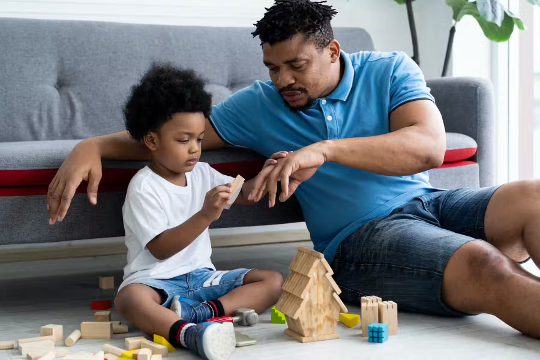Talking to your baby or toddler shapes the structure of their brain, my colleagues and I have discovered.
For the study, which is published in The Journal of Neuroscience, we enrolled 163 children at either six months of age or 30 months of age. The children wore a small audio recorder in a specially made vest for between one and three days.
We recorded all the language input they received – such as adults talking to the child, adults talking to each other and siblings talking. In total, we recorded over 6,200 hours of talk.
We also studied the development of these children’s brains. They came into the local hospital with their families around the usual bedtime and made themselves at home in a “sleepy room”. When they fell asleep, the research team lifted the child onto a trolley and moved them, still asleep, into an MRI machine.
The child had protective, noise-cancelling headphones on, and a researcher monitored them in the room the entire time. Happily, most of the children stayed asleep for the 40 minutes of scanning time.
Brain development
The brain scans we acquired focused on something called myelin. Myelin grows around nerve cells in the brain, making communication between cells more efficient. We were particularly interested in the amount of myelin in brain areas associated with language processing.
The question was whether children who heard more language would have more myelin in language-processing brain regions. This would suggest that these children had more sophisticated language-processing abilities.
And that’s what we found: the 30-month-olds who heard more words spoken by nearby adults during our recording period had more myelin in language-related brain regions. Interestingly, this relationship was quite specific, showing up in language areas of the brain, but not showing up in other areas involved in, say, movement or sensation.
So talking to your child literally shapes their brain.
We also found that adult word input matters for six-month-old infants, but here the relationship was reversed. That is, six-month-olds who heard more language had less myelin in language-related brain regions.
It is not yet clear why we see this effect. One possibility is that this finding has to do with differences in how the brain develops in the first few years of life. During the first year of life, the brain is busy growing new cells, so hearing lots of language may ramp up brain growth. Research suggests this brain growth may actually slow the formation of myelin. At the age of two and three, by contrast, the brain is busy growing myelin, so lots of input leads to lots of myelin.
This suggests that talking matters just as much at six months as at 30 months, but it affects the brain differently because the brain is in a different “state”.
It might feel a bit odd to chatter on and on to a six-month-old – clearly, they don’t understand everything you are saying. But gradually, hour by hour and day by day, it all adds up. All that chatter matters.
Good ways to talk to babies and toddlers
Of course, there are different ways babies and toddlers can be exposed to talk – reading to them, singing to them and talking to other adults when they are around. Parents might wonder if some ways of talking to babies are better than others.
The answer seems to be that early in a child’s life, quantity is important. Research has found that children raised in language-rich environments may have a leg up in early language development. This advantage, however, came from talk directed at the child – not speech between others overheard by the child.

Have conversations with your child. Amorn Suriyan/Shutterstock
But as children get older, quality may take over. High-quality “conversations”, where the child and the caregiver take turns seem to be really helpful.
A key feature of these conversations is that they are contingent – meaning that what you do and say depends on what the child does and vice versa. So when your child holds up a toy train, you say “train!” and then the child says “choo choo”, you are responding to one another contingently. Evidence suggests that these types of contingent interactions lay the foundation for early language learning.
A great way to start these conversations is to notice what your child is playing with and join in – and let them lead. Name the objects they are playing with, point out the colours and shapes, and make silly sounds. All of this will help keep their attention and help them link words with objects.
So talk to your child. Follow their lead. Play silly verbal games together. You may be helping their language development – and having some fun along the way.![]()
About The Author
John Spencer, Professor in Psychology, University of East Anglia
This article is republished from The Conversation under a Creative Commons license. Read the original article.

Related Books:
Here are 5 non-fiction books on parenting that are currently Best Sellers on Amazon.com:The Whole-Brain Child: 12 Revolutionary Strategies to Nurture Your Child's Developing Mind
by Daniel J. Siegel and Tina Payne Bryson
This book provides practical strategies for parents to help their children develop emotional intelligence, self-regulation, and resilience using insights from neuroscience.
Click for more info or to order
No-Drama Discipline: The Whole-Brain Way to Calm the Chaos and Nurture Your Child's Developing Mind
by Daniel J. Siegel and Tina Payne Bryson
The authors of The Whole-Brain Child offer guidance for parents to discipline their children in a way that promotes emotional regulation, problem-solving, and empathy.
Click for more info or to order
How to Talk So Kids Will Listen & Listen So Kids Will Talk
by Adele Faber and Elaine Mazlish
This classic book provides practical communication techniques for parents to connect with their children and foster cooperation and respect.
Click for more info or to order
The Montessori Toddler: A Parent's Guide to Raising a Curious and Responsible Human Being
by Simone Davies
This guide offers insights and strategies for parents to implement Montessori principles at home and foster their toddler's natural curiosity, independence, and love of learning.
Click for more info or to order
Peaceful Parent, Happy Kids: How to Stop Yelling and Start Connecting
by Dr. Laura Markham
This book offers practical guidance for parents to shift their mindset and communication style to foster connection, empathy, and cooperation with their children.






















